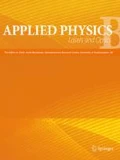Abstract
Aerosol and temperature are important parameters for forecasting the weather. Rotational Raman signals of atmospheric molecules and an elastic signal of the molecule and aerosol give good information about the temperature and aerosol extinction and backscattering coefficients. For a rotational Raman signal, we have designed a new kind of lidar signal receiving system which can sum different rotational quantum numbers from J=2, to 9 and J=11, to 20. This integration signal gives a good signal to noise ratio when compared with the temperature lidar system which use an interference filter for a single quantum number. From this new system, we can obtain the temperature parameter and aerosol scattering coefficient with good signal to noise ratio the (SNR) with a normal laser and a small telescope up to several kilometers. Temperature profiles and aerosol profiles show different shapes in different weather conditions.
Similar content being viewed by others
References
Behrendt A, Reichardt J (2000) Appl. Opt. 39:1872 (2000)
Arshinov Y, Bobrovnikov S, Serikov I, Ansmann A, Wandinger U, Althausen D, Mattis I, Müller D (2005) Appl. Opt. 44:3593
Behrendr A, Reichardt J (2000) Appl. Opt. 39:1372
She CY, Alvarez RJ II, Caldwell LM, Krueger DA (1992) Opt. Lett. 17:541
Ansmann A, Wandinger U, Riebesell M, Weitkamp C, Michaelis W (1992) Appl. Opt. 31:7113
Miles BR, Lempert WR, Forkey JN (2001) Meas. Sci. Technol. 12:R33
Whiteman DN (2003) Appl. Opt. 42:2571
Murayama T, Redmann SJ, Anderson TL, Schmid B, Livingston JM, Russel PB, Huebert B, Howell SG, McNaughton CS, Clarke A, Abo M (2003) J. Geophys. Res. 108:8651
Sakai T, Nagai T, Nakazato M, Mano Y, Matsumura T (2003) Appl. Opt. 42:7103
Cohen A, Cooney JA, Geller KN (1976) Appl. Opt. 15:2896
Kim D, Cha H, Lee J, Bobronikov S (2001) J. Korean Phys. Soc. 39:838
Kim D, Cha H (2005) Opt. Lett. 30:1728
Author information
Authors and Affiliations
Corresponding author
Additional information
PACS
42.62.Fi; 42.68.Jg; 42.68.Ge; 42.15.Eq; 42.58.Wt
Rights and permissions
About this article
Cite this article
Kim, D., Park, S., Cha, H. et al. New multi-quantum number rotational Raman lidar for obtaining temperature and aerosol extinction and backscattering scattering coefficients. Appl. Phys. B 82, 1–4 (2006). https://doi.org/10.1007/s00340-005-2064-2
Received:
Revised:
Published:
Issue Date:
DOI: https://doi.org/10.1007/s00340-005-2064-2




